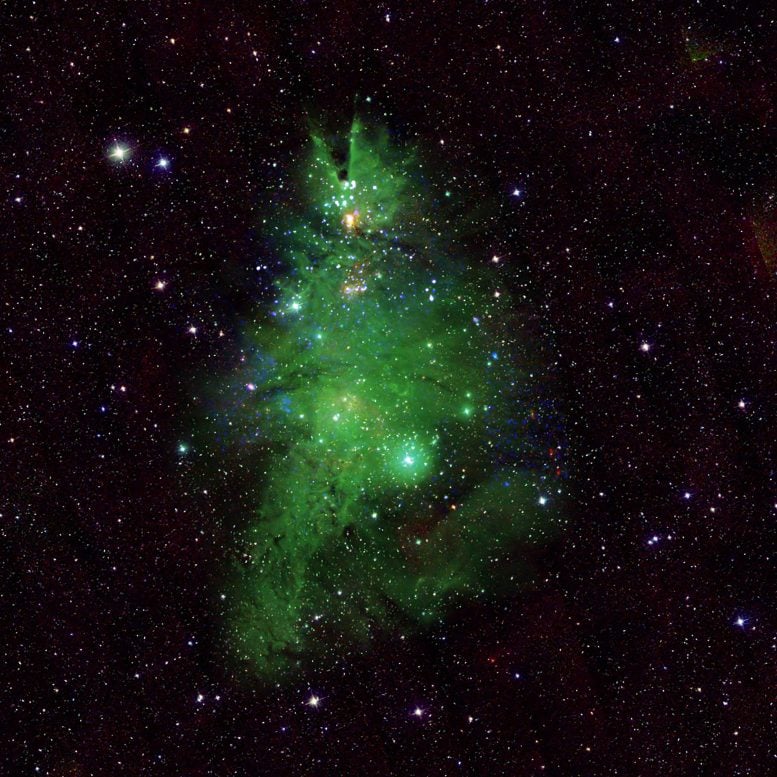The “Christmas Tree Cluster” NGC 2264 is a young star cluster in the Milky Way, about 2,500 light-years away from Earth. Enhanced through specific color selections and rotations, this composite image depicts these stars of varying sizes as part of a cosmic Christmas tree. Image source: X-ray: NASA/CXC/SAO; Optical: TA Rector (NRAO/AUI/NSF and NOIRLab/NSF/AURA) and BA Wolpa (NOIRLab/NSF/AURA); Infrared: NASA/NSF/IPAC/CalTech/ Univ. Massachusetts; Image processing: NASA/CXC/SAO/L.Fratar and J. Major
NGC 2264, the “Christmas Tree Cluster”, is a star cluster within a cluster Milky Waydepicted in a newly enhanced image that resembles a cosmic Christmas tree.
- NGC 2264 is a cluster of young stars that has been colored and rotated to emphasize its nickname of the “Christmas Tree Cluster.”
- This composite image contains X-rays from Chandra (blue and white), optical data from WIYN (green gas), and infrared data from 2MASS (white star).
- The stars in this cluster are between 1 and 5 million years old, while the Sun is 5 billion years old.
- Young stars are unstable and produce strong flares in X-rays and other types of light, but not in any coordinated way as shown in the animation.
Cosmic Christmas Tree: The stellar wonders of NGC 2264
This new image of NGC 2264, also known as the “Christmas Tree Cluster,” shows the shape of a cosmic tree glowing with stars. In fact, NGC 2264 is a group of young stars in the Milky Way about 2,500 light-years from Earth, ranging in age from 1 to 5 million years old. The stars in NGC 2264 are both smaller and larger than the Sun, with some containing less than one-tenth the mass of the Sun and others containing about 7 solar masses.
Holiday Composite Image: Color and Spin
This new composite image enhances the resemblance to a Christmas tree through color and rotation choices. The blue and white lights (flashing in the animated version – see video below) are young stars, which emit X-rays, NASAChandra X-ray Observatory. Optical data from the WIYN 0.9-meter telescope at Kitt Peak, supported by the National Science Foundation, show that the gas nebulae in the cluster appear green, corresponding to the “pine needles” on the trees. Finally, infrared data from the Two Micron All-Sky Survey shows foreground and background stars as white. The image has been rotated 160 degrees clockwise from the standard where astronomers point upward, so it looks like the top of the tree is facing the top of the image.
This composite image shows clusters of Christmas trees. The blue and white lights (flashing in the animated version of this image) are young stars that emit X-rays detected by NASA’s Chandra X-ray Observatory. Optical data from the National Science Foundation’s WIYN 0.9-meter telescope at Kitt Peak shows the gas in the nebula appears green, corresponding to the tree’s “pine needles,” and infrared data from the Two Micron All-Sky Survey shows foreground and background stars white of. The image has been rotated about 160 degrees clockwise from the standard that astronomers point upward, so it looks like the tops of the trees are toward the top of the image.
Stellar Dynamics and Observation Techniques
Young stars, like those in NGC 2264, are volatile, producing strong flares in X-rays and other types of changes seen in different wavelengths of light. However, the coordinated twinkling changes shown in this animation are artificial and are intended to emphasize the position of the stars seen in X-rays and emphasize the object’s similarity to a Christmas tree. In fact, the stars don’t change in sync.
The changes observed by Chandra and other telescopes are caused by several different processes. Some of these are related to activity involving magnetic fields, including flares like those experienced by the Sun (but more powerful), as well as hot spots and dark areas on the star’s surface that move in and out of view as the star rotates. The thickness of the gas obscuring the star may also change, as may the amount of material falling onto the star from the surrounding disk of gas.
NASA’s Marshall Space Flight Center manages the Chandra program. The Smithsonian Astrophysical Observatory’s Chandra X-ray Center controls science operations in Cambridge, Massachusetts, and flight operations in Burlington, Massachusetts.
#Astronomy #art #NASA #brings #Christmas #tree #clusters #life
Image Source : scitechdaily.com
